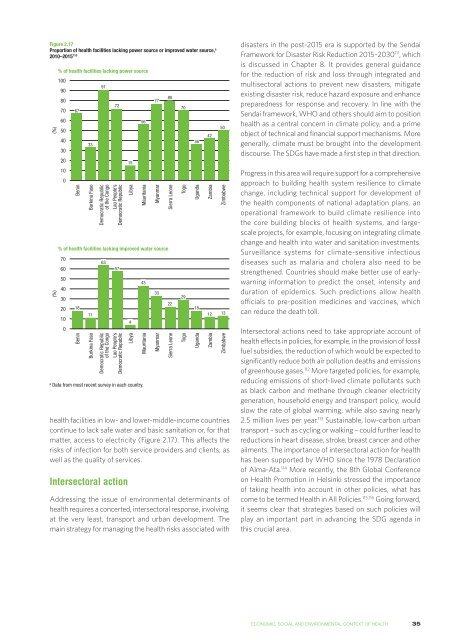Create successful ePaper yourself
Turn your PDF publications into a flip-book with our unique Google optimized e-Paper software.
Figure 2.17<br />
Proportion of health facilities lacking power source or improved water source, a<br />
2010–2015 110<br />
(%)<br />
(%)<br />
% of health facilities lacking power source<br />
100<br />
90<br />
80<br />
70<br />
60<br />
50<br />
40<br />
30<br />
20<br />
10<br />
0<br />
67<br />
Benin<br />
33<br />
Burkina Faso<br />
Democratic Republic<br />
of the Congo<br />
Lao People’s<br />
Democratic Republic<br />
a<br />
Data <strong>from</strong> most recent survey in each country.<br />
91<br />
health facilities in low- and lower-middle-income countries<br />
continue <strong>to</strong> lack safe water and basic sanitation or, for that<br />
matter, access <strong>to</strong> electricity (Figure 2.17). This affects the<br />
risks of infection for both service providers and clients, as<br />
well as the quality of services.<br />
Intersec<strong>to</strong>ral action<br />
Libya<br />
Mauritania<br />
Addressing the issue of environmental determinants of<br />
health requires a concerted, intersec<strong>to</strong>ral response, involving,<br />
at the very least, transport and urban development. The<br />
main strategy for managing the health risks associated with<br />
Myanmar<br />
% of health facilities lacking improved water source<br />
70<br />
60<br />
50<br />
40<br />
30<br />
20<br />
10<br />
0<br />
18<br />
Benin<br />
11<br />
Burkina Faso<br />
63<br />
72<br />
57<br />
Democratic Republic<br />
of the Congo<br />
Lao People’s<br />
Democratic Republic<br />
15<br />
4<br />
Libya<br />
56<br />
43<br />
Mauritania<br />
77<br />
33<br />
Myanmar<br />
80<br />
Sierra Leone<br />
22<br />
Sierra Leone<br />
70<br />
Togo<br />
29<br />
Togo<br />
36<br />
Uganda<br />
18<br />
Uganda<br />
42<br />
Zambia<br />
Zambia<br />
50<br />
Zimbabwe<br />
12 13<br />
Zimbabwe<br />
disasters in the post-2015 era is supported by the Sendai<br />
Framework for Disaster Risk Reduction 2015–2030 111 , which<br />
is discussed in Chapter 8. It provides general guidance<br />
for the reduction of risk and loss through integrated and<br />
multisec<strong>to</strong>ral actions <strong>to</strong> prevent new disasters, mitigate<br />
existing disaster risk, reduce hazard exposure and enhance<br />
preparedness for response and recovery. In line with the<br />
Sendai framework, WHO and others should aim <strong>to</strong> position<br />
health as a central concern in climate policy, and a prime<br />
object of technical and financial support mechanisms. More<br />
generally, climate must be brought in<strong>to</strong> the development<br />
discourse. The SDGs have made a first step in that direction.<br />
Progress in this area will require support for a comprehensive<br />
approach <strong>to</strong> building health system resilience <strong>to</strong> climate<br />
change, including technical support for development of<br />
the health components of national adaptation plans, an<br />
operational framework <strong>to</strong> build climate resilience in<strong>to</strong><br />
the core building blocks of health systems, and largescale<br />
projects, for example, focusing on integrating climate<br />
change and health in<strong>to</strong> water and sanitation investments.<br />
Surveillance systems for climate-sensitive infectious<br />
diseases such as malaria and cholera also need <strong>to</strong> be<br />
strengthened. Countries should make better use of earlywarning<br />
information <strong>to</strong> predict the onset, intensity and<br />
duration of epidemics. Such predictions allow health<br />
officials <strong>to</strong> pre-position medicines and vaccines, which<br />
can reduce the death <strong>to</strong>ll.<br />
Intersec<strong>to</strong>ral actions need <strong>to</strong> take appropriate account of<br />
health effects in policies, for example, in the provision of fossil<br />
fuel subsidies, the reduction of which would be expected <strong>to</strong><br />
significantly reduce both air pollution deaths and emissions<br />
of greenhouse gases. 112 More targeted policies, for example,<br />
reducing emissions of short-lived climate pollutants such<br />
as black carbon and methane through cleaner electricity<br />
generation, household energy and transport policy, would<br />
slow the rate of global warming, while also saving nearly<br />
2.5 million lives per year. 113 Sustainable, low-carbon urban<br />
transport – such as cycling or walking – could further lead <strong>to</strong><br />
reductions in heart disease, stroke, breast cancer and other<br />
ailments. The importance of intersec<strong>to</strong>ral action for health<br />
has been supported by WHO since the 1978 Declaration<br />
of Alma-Ata. 114 More recently, the 8th Global Conference<br />
on Health Promotion in Helsinki stressed the importance<br />
of taking health in<strong>to</strong> account in other policies, what has<br />
come <strong>to</strong> be termed Health in All Policies. 115,116 Going forward,<br />
it seems clear that strategies based on such policies will<br />
play an important part in advancing the SDG agenda in<br />
this crucial area.<br />
ECONOMIC, SOCIAL AND ENVIRONMENTAL CONTEXT OF HEALTH<br />
35


